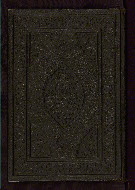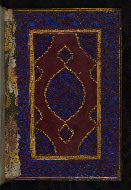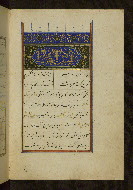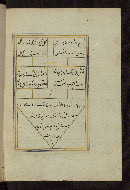Home > Digitized Walters Manuscripts
This document is a tranformation of a TEI P5 XML manuscript description incorporating images. If you have trouble reading special or non-Latin characters on this page, please make sure you have appropriate Unicode fonts installed and an up-to-date web browser.
Walters Ms. W.641, Selection of poems
Browse images (Browse images in a new window) | TEI in XML format
W.641
Selection of poems
Vernacular: منتخب جامي
Authority name: Jāmī, 1414-1492
As-written name: Nūr al-Dīn ʿAbd al-Raḥmān ibn Aḥmad Jāmī
Name, in vernacular: نور الدين عبد الرحمان بن احمد جامى
Note: Author dates preferred by cataloger: d. 898 AH / 1492 CE
This manuscript is an illuminated Timurid copy of a selection of poems by Nūr al-Dīn ʿAbd al-Raḥmān Jāmī (d. 898 AH / 1492 CE). The colophon indicates that it was copied in Herat (present-day Afghanistan) by Sulṭān ʿAlī in 899 AH / 1493-4 CE (fol. 70b). The manuscript opens with an illuminated incipit with an inscribed headpiece. The black leather binding, which is original to the manuscript, has a stamped central lobed oval, pendants, and cornerpieces, which are all covered with cloudband motifs.The doublures of red leather with similar design are decorated with filigree work on a blue ground. There is an erased bequest (waqf) seal and registration statement, probably belonging to the Sultan ʿUthmān (reg. 1027-31 AH / 1618-22 CE) (fol. 1a).
899 AH / 1493-4 CE
Herat (present-day Afghanistan)
As-written name: Sulṭān ʿAlī
Name, in vernacular: سلطان علي
Book
Literary -- Poetry
The primary language in this manuscript is Persian.
- Transliteration: qad faragha min taswīd h<ā>dh<ā> al-kitāb bi-ʿawn al-malik al-wahhāb aqall al-ʿibād /1/ Sulṭān ʿAlī tajāwaza Allāh ʿan sayyiā<ʾ>ātih fī shuhūr /2/ sanat tisʿ wa-tisʿīn wa-thamānimi<ʾ>ah /3/ bi-baldat Harāt /4/ m [=tamma] /5/
- Comment: Written in Arabic; gives name of the scribe, as well as date and place of copying
Paper
Thick, well-polished, off-white paper
Foliation: iii+70+iii
Catchwords: Written obliquely on versos
11.5 cm wide by 17.0 cm high
7.0 cm wide by 11.0 cm high
- Columns: 2
- Ruled lines: 11
- Framing lines in gold, black, and blue
- Title: Muntakhab-i Jāmī
- Author: Jāmī, 1414-1492
- Scribe: Sulṭān ʿAlī
- Incipit: بسم الله الرحمن الرحيم اعلى حمد المنان الكريم ...
- Text note: Apparently composed in 885 AH / 1480-1 CE (date given in a chronosticon at the end of the introduction on fol. 3a)
- Hand note: Written in black nastaʿlīq script; illuminated headpiece written in New Abbasid (broken cursive) style; headings and incidentals written in red, gold, and blue
- Decoration note: Illuminated headpiece inscribed Allāh wa-lā siwāhu in New Abbasid (broken cursive) style (fol. 1b); headings and incidentals in red, gold, and blue; framing lines in gold, black, and blue
Upper board outside:

- Title: Binding
- Form: Binding
- Label: This black leather binding, which is original to the manuscript, has a stamped central lobed oval, pendants, and cornerpieces, all covered with cloudband motifs.
Upper board inside:

- Title: Doublure
- Form: Doublure
- Label: This red doublure, which is original to the manuscript, is decorated with a central lobed oval, pendants, and cornerpieces decorated with filigree work on a blue ground. A strip of marbled paper is present at the hinge.
fol. 1b:

- Title: Illuminated incipit with headpiece
- Form: Incipit; headpiece
- Label: This illuminated headpiece is inscribed Allāh wa-lā siwāhu in gold in the New Abbasid (broken cursive) style on a deep blue background. Incidentals are written in gold.
fol. 70b:

- Title: Illuminated colophon
- Form: Colophon
- Label: In this colophon the scribe Sulṭān ‘Alī indicates that the manuscript was completed in 899 AH / 1493-4 CE in the city of Herat, which is in present day Afghanistan. It reads as follows: qad faragha min taswīd h<ā>dh<ā> al-kitāb bi-ʿawn al-malik al-wahhāb aqall al-ʿibād /1/ Sulṭān ʿAlī tajāwaza Allāh ʿan sayyiā<ʾ>ātih fī shuhūr /2/ sanat tisʿ wa-tisʿīn wa-thamānimi<ʾ>ah /3/ bi-baldat Harāt /4/ m [=tamma] /5/
The binding is original.
Black leather binding (with flap); stamped central lobed oval, pendants, and cornerpieces, all decorated with a cloudband motif; red doublures with central lobed oval, pendants, and cornerpieces decorated with filigree work on a blue ground; strip of marbled paper at hinges
Name of scribe, date, and place of copying given in colophon (fol. 70b)
Erased bequest (waqf) seal and registration statement, probably belonging to Sultan ʿUthmān (reg. 1027-31 AH / 1618-22 CE) (fol. 1a)
Walters Art Museum, 1931, by Henry Walters bequest
Principal cataloger: Gacek, Adam
Catalogers: Landau, Amy; Smith, Sita
Editor: Bockrath, Diane
Conservators: Jewell, Stephanie; Quandt, Abigail
Contributors: Barrera, Christina; Emery, Doug; Herbert, Lynley; Noel, William; Simpson, Shreve; Tabritha, Ariel; Toth, Michael B.; Valle, Chiara
The Walters Art Museum
Licensed for use under Creative Commons Attribution-NonCommercial-ShareAlike 3.0 Unported Access Rights, http://creativecommons.org/licenses/by-nc-sa/3.0/legalcode. It is requested that copies of any published articles based on the information in this data set be sent to the curator of manuscripts, The Walters Art Museum, 600 North Charles Street, Baltimore MD 21201.